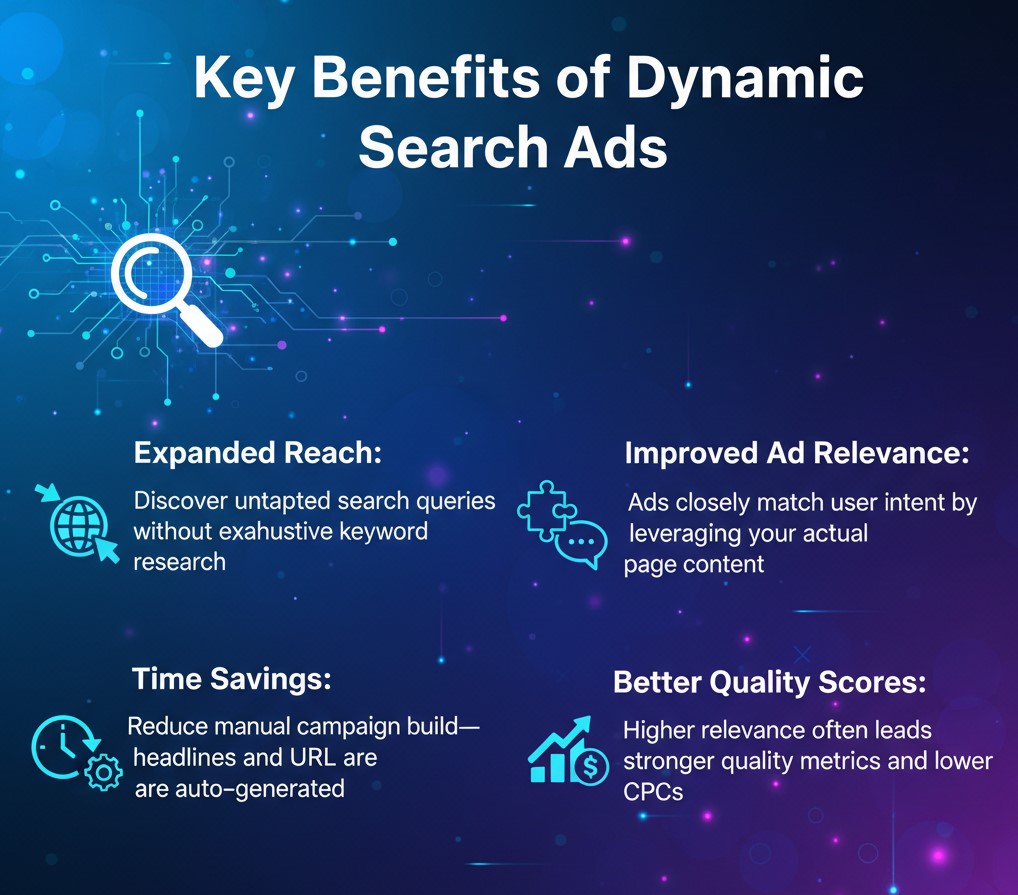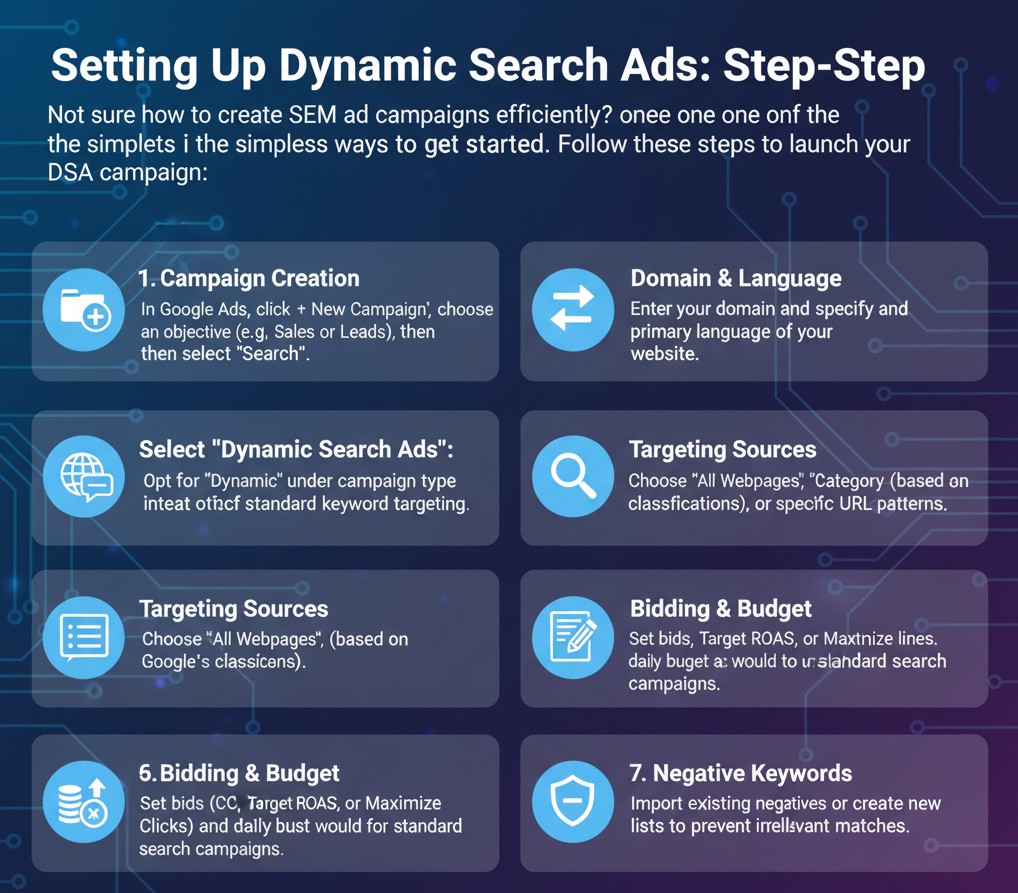
Search Engine Marketing (SEM) continues to evolve as advertisers demand more efficiency, broader reach, and better return on ad spend (ROAS). While keyword-based campaigns remain the backbone of paid search, Dynamic Search Ads (DSAs) have emerged as a powerful complementary format. Unlike traditional text ads that require manual keyword selection, DSAs automatically generate headlines and landing pages based on your website’s content and user search queries. This guide dives deep into what DSAs are, their benefits, how to set them up, best practices, common pitfalls, and advanced optimization strategies.
What Are Dynamic Search Ads?
Dynamic Search Ads are an automated ad format offered by Google Ads and other platforms that crawl your website to match user queries with your product and service pages. Instead of relying on a fixed keyword list, DSAs dynamically create ad headlines and select the most relevant landing page. This process helps you capture additional search demand that might not be covered by your existing keyword portfolios.
How Dynamic Search Ads Work
Under the hood, DSAs use three key components:
- Crawling & Inventory Creation: Google’s algorithm crawls the selected domains, identifying pages and extracting content themes.
- Query Matching: When a user submits a search that aligns with your indexed content and campaign targeting, the system triggers a DSA auction.
- Dynamic Ad Generation: Google assembles an ad by pulling the most relevant headlines from your page content and directs the user to the optimal landing page. You supply two description lines and set budgets and bids as usual.
Key Benefits of Dynamic Search Ads

- Expanded Reach: Discover untapped search queries without exhaustive keyword research.
- Time Savings: Reduce manual campaign build—headlines and URLs are auto-generated.
- Improved Ad Relevance: Ads closely match user intent by leveraging your actual page content.
- Better Quality Scores: Higher relevance often leads to stronger quality metrics and lower CPCs.
When to Use Dynamic Search Ads
DSAs excel in scenarios such as:
- Large, frequently updated catalogs: E-commerce sites with dynamic inventories.
- Niche or long-tail opportunity discovery: Capturing queries you may have overlooked.
- Supplementing existing keyword campaigns: Filling coverage gaps without keyword bloat.
- Time-constrained campaigns: Quickly launch ads without detailed keyword lists.
Setting Up Dynamic Search Ads: Step-by-Step

Not sure how to create SEM ad campaigns efficiently? Dynamic Search Ads offer one of the simplest ways to get started. Follow these steps to launch your DSA campaign:
- Campaign Creation: In Google Ads, click “+ New Campaign,” choose an objective (e.g., Sales or Leads), then select “Search.”
- Select “Dynamic Search Ads”: Opt for “Dynamic” under campaign type instead of standard keyword targeting.
- Domain & Language: Enter your domain and specify the primary language of your website.
- Targeting Sources: Choose “All Webpages,” “Category” (based on Google’s classifications), or specific URL patterns.
- Ad Creation: Provide up to two description lines. Headlines and final URLs will be automated.
- Bidding & Budget: Set bids (CPC, Target ROAS, or Maximize Clicks) and daily budget as you would for standard search campaigns.
- Negative Keywords: Import existing negatives or create new lists to prevent irrelevant matches.
- Launch & Monitor: Review search terms after a week to refine negatives and adjust bids.
Best Practices for DSA Campaigns
To maximize performance, implement these proven tactics:
- Granular URL Targeting: Group similar pages (e.g., by brand, product category) into separate ad groups to tailor bids and ad copy descriptions.
- Robust Negative Keyword Lists: Continuously mine search term reports to exclude irrelevant or underperforming queries.
- Custom Description Copy: Write compelling, benefit-driven description lines that apply to all dynamic headlines.
- Bid Adjustments: Use device, location, and demographic modifiers to optimize for your highest-value segments.
- A/B Testing: Split-test standard search ads against DSAs to quantify incremental gains.
Common Pitfalls & How to Avoid Them
- Broad Targeting Without Negatives: Leads to wasted spend. Invest in negative keywords early.
- Over-Aggregation: A single DSA ad group for an entire site can obscure insights. Segment by theme.
- Missing Conversion Tracking: You can’t optimize what you don’t measure. Ensure accurate goal tracking.
- Ignoring Search Term Reports: Regularly review to refine targeting and negatives.
Advanced Optimization Strategies
Once you have baseline performance, push efficiency further with these methods:
- Dynamic Descriptions via API: Use Google Ads scripts or the API to rotate multiple description variants based on page categories.
- Feed-Based DSAs: Upload a custom page feed to control exactly which URLs are eligible and supply custom labels for hyper-targeted segmentation.
- Bid Strategy Automation: Layer Target ROAS or Target CPA bidding on top of DSA campaigns to let machine learning optimize bids in real time.
- Cross-Campaign Exclusions: Avoid overlap by excluding DSA query matches from manual keyword campaigns and vice versa.
- Seasonal Adjustments: Use bid adjustments or automated rules to adapt to peak periods, promotions, or product launches.
Measuring Success and Iterating
Key metrics to track for DSAs include:
- Click-Through Rate (CTR): Gauge relevance of dynamically generated headlines.
- Conversion Rate (CVR): Assess landing page alignment and user intent match.
- Cost per Conversion (CPA): Ensure bid strategies align with profitability goals.
- Search Term Volume: Identify new keywords for manual campaigns or negatives to refine DSA targeting.
Regularly audit your DSA campaigns—ideally weekly for negatives and monthly for structural refinements. Combine qualitative insights (e.g., landing page user experience) with quantitative data to make informed adjustments.
Conclusion
Dynamic Search Ads offer SEM practitioners an efficient way to scale coverage, tap into new search demand, and maintain high ad relevance—all while reducing manual keyword management. By following the setup steps, adhering to best practices, avoiding common mistakes, and continuously optimizing with advanced strategies, you can unlock significant ROI gains. Whether you’re managing a large e-commerce site or a lead-gen portfolio, integrating DSAs into your SEM mix will help you stay ahead of the competition and capture incremental traffic you might otherwise miss.
Ready to power up your SEM campaigns? Start your first DSA ad group today, monitor performance closely, and apply the tactics in this guide to maximize automated campaign success.
Learn more about: SEM for Voice Search: How to Optimize Campaigns for Conversational Queries


Leave a Reply